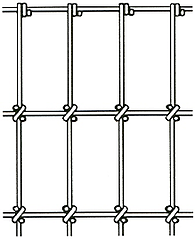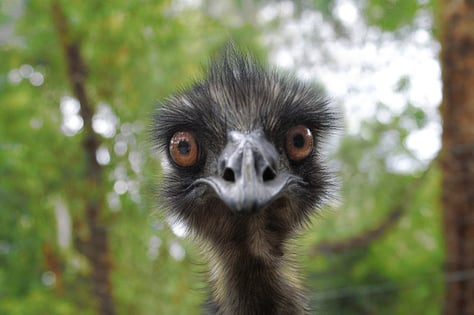These grand, imposing, flightless birds are probably as tall or taller than you. Some folks consider them pets, some consider them products. Whichever, we'll start with a brief description, then recommend the right fence, followed by explaining this bird's unique nesting habits.
How big is big?
Obviously, if you're choosing an emu as a pet, your taste is somewhat extravagant and you no doubt realize that an appropriate space for this very large bird should be one of your first concerns. Here are some considerations:
- They range from 5 to 6½ feet tall
- weighing up to 130 lbs
- They can run up to 30 miles per hour
- Imagine these big birds traveling hundreds of miles for food and water in the Australian outback. They need space and for healthy birds, you must provide an opportunity for exercise. A long pen is recommended so they can run--at least ¼ acre to 2 acres in size.
- Audible--their grunts and squawks can be heard up to 2 miles away. You might want to think about your neighbors as you plan your emu enclave.
- Emus are especially docile toward humans especially if they are handled from birth. If an emu feels threatened, its claws can do real damage. Other small animals in the yard, such as chickens, can be trampled.
- They like baths and enjoy an occasional dip. In a pinch, a child's paddling pool can suffice.

Now, about that fence...
Your emu will benefit from a 2" x 4" woven, non-climbable mesh fence that is five to six feet high. It is attractive, has a long lifetime, and makes a safe and secure fence for emus. The strong 10, 12½ or 14 gauge steel wires (depending on style) are treated for maximum rust and corrosion protection. The heavier wires used on the top and bottom edges give this fence additional strength. Stiff "square" knots, formed by a third piece of wire woven around each intersection, hold the horizontal and vertical wires securely. The mesh offers flexibility, allowing for its construction on uneven terrain. The woven knots are rust-resistant and will not hold water. This fence features knots that are smooth, which protect both animals and people from injury.
The Broody Male
Females are larger than males and can exhibit aggressive behavior, especially during breeding season. They lay their eggs and wander off, leaving the males in charge of the nursery. The males build their nests in a shallow hole in the ground using grasses, leaves, and sticks. After the female lays her eggs, the male steps in. He becomes broody and takes control, remaining on the nest for 8 weeks until the emu chicks hatch.
Generally, the males may seem friendlier, being the nest tenders--yet much more defensive of the newly hatched chicks than of the eggs which can be removed from the nest without much upset. The male doesn't leave the nest, his sole activity (no eating, drinking or even defecating!) is to turn the eggs a couple of times a day and understandably, during this stretch of time, he loses a third of his body weight. Once hatched, they will remain with their father up to a year and a half and are ready for breeding between two and three years of age.
While the female usually abandons this domestic scene, she goes on to mate with other males and will produce up to three clutches (between 5 and 15 eggs in a season.) In her wandering, the female may deposit eggs in the nests of males with whom she hasn't bred. The large eggs weigh about a pound, are teal in color, and measure about 3 inches wide and 5 inches long. Thinking culinarily, a single egg contains the equivalent of 10-12 chicken eggs with a richness similar to duck eggs.
Assorted Emu Facts
- Emus are in the family of originally southern hemisphere flightless birds known as ratites which include ostriches, kiwis, rheas, and the cassowary.
- They are omnivores.
- Their diet consists of nuts, seeds, fruit, bark, stems, insects, small reptiles, amphibians, and small animals.
- One mature emu contains three gallons of oil, which is prized for its moisturizing and anti-inflammatory properties.
- They spend a good amount of their days pecking at things, quite indiscriminately; so an environment that provides foraging possibilities, with plenty of shrubs, dirt (they extract minerals), pebbles (used for digestion), and insects, will keep them occupied, reduce boredom and may decrease pecking of the fence.
- Pens must be kept clear of any trash, wires, nails, etc, to avoid trips to the vet.
- Pacing can be a sign of stress due to being confined.
- In the bush of Australia, the usual predators of emus are dingos, the native wild dogs. Eagles can also attack from above. The eggs and smaller chicks are sought by a number of animals and reptiles, but the ever-vigilant male rarely allows opportunity.
- Life expectancy of an emu is 10 to 20 years in the wild and up to 30 years in captivity.
The Australian Coat of Arms
Note: if you're interested in keeping ostriches, fence-wise, much of what applies to emus applies to them. And know that a 2" x 4" woven, non-climbable mesh fence is also used for:
• Garden fence
• Horse paddock fence
• Parks and public areas
• Dog kennels and containment
























